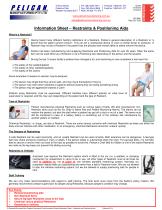
Catalog excerpts

5 Ruse Street Osborne Park Western Australia 6017 Quality Endorsed Company MANUFACTURING PTY LTD www.pelicanmanufacturing.com.au sales@pelicanmanufacturing.com.au Information Sheet – Restraints & Positioning Aids What is a Restraint? Having heard many different facility’s definitions of a Restraint, Pelican’s general description of a Restraint is “a device that the patent cannot remove”. This can be a mechanical device or even a mental threat to someone. A Restraint may not be a Restraint if the patient has the physical and mental ability to safely remove the device. Pelican has been manufacturing and supplying Restraints and Positioning Aids for over 25 years. Often the same item can be used either as a Restraint or as a Positioning Aid, depending on the person and the situation. During the last 10 years facility’s policies have changed a lot, and restraining is now considered a last resort for: The safety of the resident/patient The safety of other residents/patients The safety of the Carers Some examples of reasons to restrain may be because: The person may forget that they cannot walk, and may injure themselves if they try The person may harm other residents or patients without knowing they are doing something wrong The person may be aggressive towards a Carer Patients using Restraints must be supervised. Different facilities have different policies on what level of supervision is required, and this may vary depending on the patient and the type of Restraint. Type of Restraints Pelican manufactures physical Restraints such as various types of belts. We also manufacturer nonRestraint items such as the Sit, Slide & Stand Pad and Patient Monitoring Alarms. The alarms do not restrain the person, but alert the staff when a patient has got off a chair or out of a bed. The items must still be monitored in case of a battery failure or something out of the ordinary like interference by another patient or resident. Chemical Restraints, i.e. drugs, are also a Restraint. There are some serious concerns with chemical Restraints as these can affect the body and can interfere with other medication. In an emergency, chemical Restraints cannot be ‘undone’ quickly. The Dangers of Restraining A safe Restraint can be used incorrectly, and an unsafe Restraint can be used correctly. Both scenarios can be dangerous. A lap-type belt may choke someone resulting in injury or death, if the person slides or submarines down the chair. For lap-type belts, it is normally best to secure or anchor them as close to the hips as possible to avoid this. Pelican’s Chair Belt for Sliders is one of the safest Restraints we make as the leg loops can prevent this sliding occurring. Restraints in Vehicles Australian Law requires the Restraint system which is fitted to the car (i.e. a seatbelt, or clamping mechanism for wheelchairs in vans) to be in use. All other types of Restraint must at all times be used in addition to, not in place of, the vehicles standard restraining system. Normally our customers require belts as a positioning aid rather than a belt to Restraint them. We are not allowed to alter the vehicles restraining system, but we are allowed to supply positioning aids for people in cars. Staff Training We can only make recommendations with regard to staff training. The final word must come from the facility’s policy makers. We generally recommend constant supervision for people using Restraints, because people’s condition may change. Key Points: Restraint/positioning aids Non-Restraint items Secure lap-type Restraints close to the hips Chemical versus physical Restraints Restraints in vehicles S:\Restored\Docs\aacOther Peoples Documents\Tom\Information Sheets\Information Sheet – Restraints and Positioning Aids
Open the catalog to page 1All Pelican Manufacturing catalogs and technical brochures
-
Slings Wear & Tear
2 Pages
-
Slings Compatibility
2 Pages
-
Pelican Alarms
2 Pages
-
Slide Boards
1 Pages
-
Bed Slide Sheets
1 Pages








